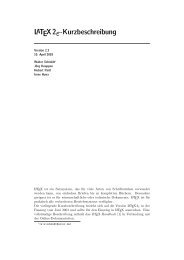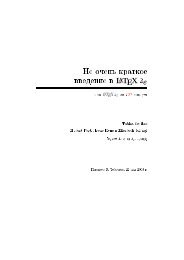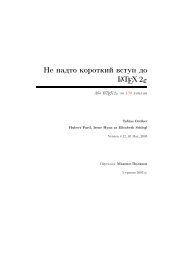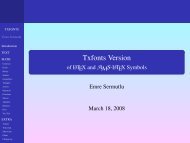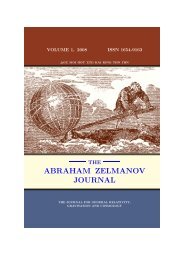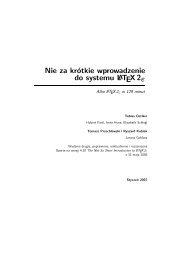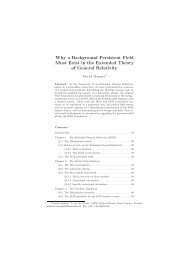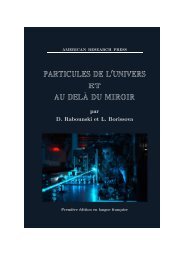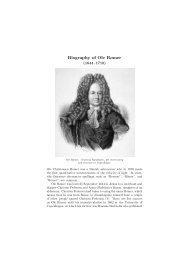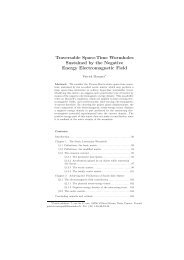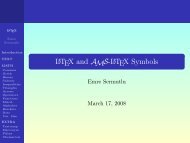The Comprehensive LaTeX Symbol List
The Comprehensive LaTeX Symbol List
The Comprehensive LaTeX Symbol List
Create successful ePaper yourself
Turn your PDF publications into a flip-book with our unique Google optimized e-Paper software.
\DeclareFontFamily{U}{bulb}{}\DeclareFontShape{U}{bulb}{m}{n}{ lightbulb10}{}Figure 6: L A TEX 2ε font-description file (ubulb.fd)such as LightBulb10 it would be reasonable to merge ubulb.fd into lightbulb.sty instead of maintainingtwo separate files. In either case, a document need only include “\usepackage{lightbulb}” to make the\lightbulb symbol available.\newcommand{\lightbulb}{{\usefont{U}{bulb}{m}{n}A}}Figure 7: L A TEX 2ε style file (lightbulb.sty)METAFONT normally produces bitmapped fonts. However, it is also possible, with the help of someexternal tools, to produce PostScript Type 1 fonts. <strong>The</strong>se have the advantages of rendering better in Adobe ®Acrobat ® (at least in versions prior to 6.0) and of being more memory-efficient when handled by a PostScriptinterpreter. See http://www.tex.ac.uk/cgi-bin/texfaq2html?label=textrace for pointers to tools that canproduce Type 1 fonts from METAFONT.7.4 Math-mode spacingTerms such as “binary operators”, “relations”, and “punctuation” in Section 3 primarily regard the surroundingspacing. (See the Short Math Guide for L A TEX [Dow00] for a nice exposition on the subject.) To use a symbolfor a different purpose, you can use the TEX commands \mathord, \mathop, \mathbin, \mathrel, \mathopen,\mathclose, and \mathpunct. For example, if you want to use \downarrow as a variable (an “ordinary”symbol) instead of a delimiter, you can write “$3 x + \mathord{\downarrow}$” to get the properly spaced“3x + ↓” rather than the awkward-looking “3x+ ↓”. Similarly, to create a dotted-union symbol (“ ˙∪”) thatspaces like the ordinary set-union symbol (\cup) it must be defined with \mathbin, just as \cup is. Contrast“$A \dot{\cup} B$” (“A ˙∪B”) with “$A \mathbin{\dot{\cup}} B$” (“A ˙∪B”). See <strong>The</strong> TEXbook [Knu86a]for the definitive description of math-mode spacing.<strong>The</strong> purpose of the “log-like symbols” in Tables 120 and 121 is to provide the correct amount of spacingaround and within multiletter function names. Table 284 contrasts the output of the log-like symbols withvarious, naïve alternatives. In addition to spacing, the log-like symbols also handle subscripts properly. Forexample, “\max_{p \in P}” produces “max p∈P ” in text, but “max” as part of a displayed formula.p∈PTable 284: Spacing Around/Within Log-like <strong>Symbol</strong>sL A TEX expressionOutput$r \sin \theta$ r sin θ (best)$r sin \theta$ rsinθ$r \mbox{sin} \theta$ rsinθ$r \mathrm{sin} \theta$ rsinθ<strong>The</strong> amsmath package makes it straightforward to define new log-like symbols:\DeclareMathOperator{\atan}{atan}\DeclareMathOperator*{\lcm}{lcm}<strong>The</strong> difference between \DeclareMathOperator and \DeclareMathOperator* involves the handling of subscripts.With \DeclareMathOperator*, subscripts are written beneath log-like symbols in display style andto the right in text style. This is useful for limit operators (e.g., \lim) and functions that tend to map overa set (e.g., \min). In contrast, \DeclareMathOperator tells TEX that subscripts should always be displayedto the right of the operator, as is common for functions that take a single parameter (e.g., \log and \cos).Table 285 contrasts symbols declared with \DeclareMathOperator and \DeclareMathOperator* in both textstyle ($. . .$) and display style (\[. . .\]). 1111 Note that \displaystyle can be used to force display style within $. . .$ and \textstyle can be used to force text stylewithin \[. . .\].99



